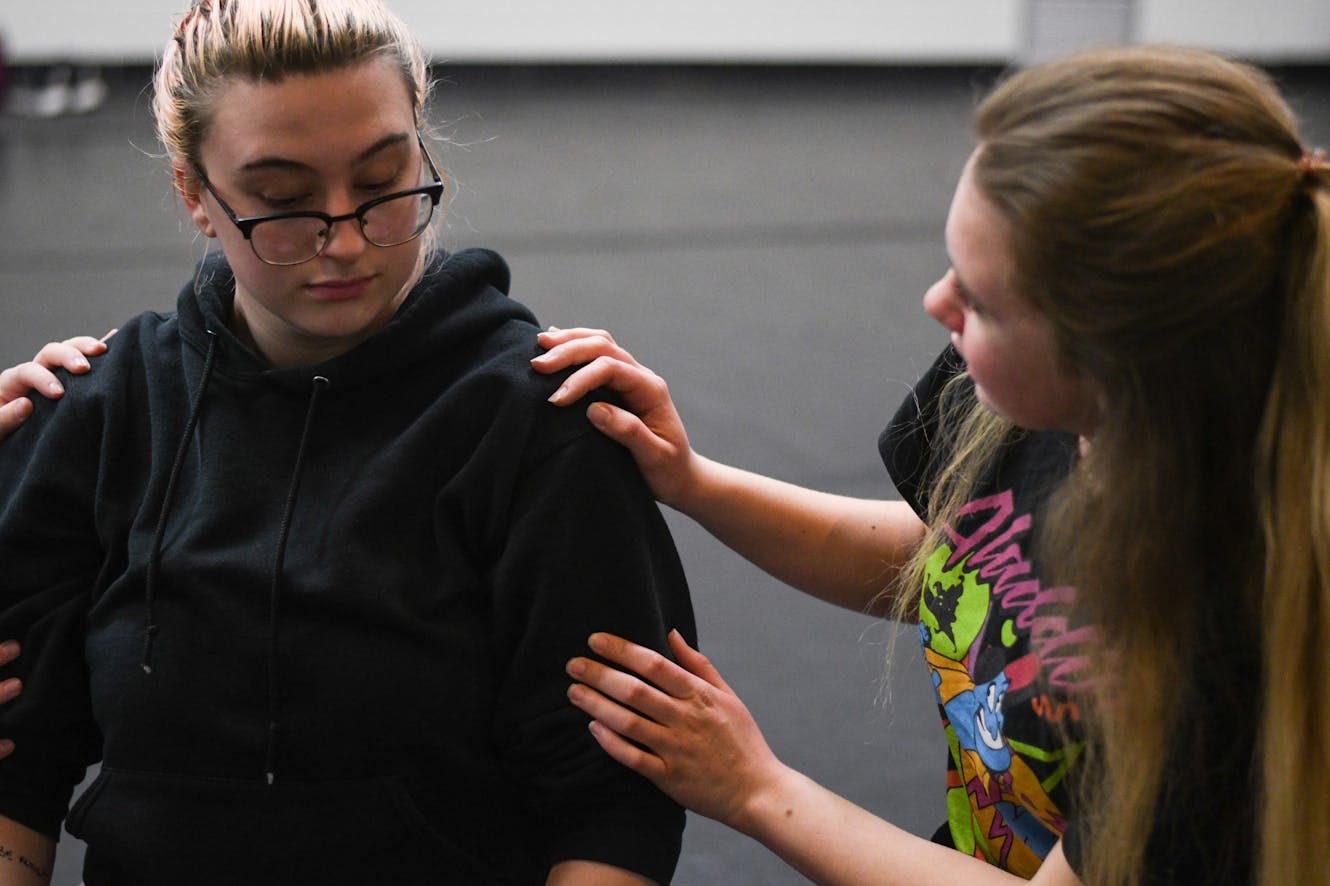CMU senior choreographs original dance to share coming-out story
Dance of identity

Ionia Senior Mahlea Maresh reaches out to the audience while dancing Wednesday, April 12, in the Townsend Kiva. This dance was part of the Drama in the Drama Department Cabaret, and will also be performed May 3 in Rose 127.
Mahlea Maresh has a message.
"To people who don’t consider themselves traditional dancers, please don’t ever be afraid to dance. … It helps you express who you are," she said. "Dance for you, don’t dance for anyone else."
Mahlea Maresh is a musical theater major and a third-year student at Central Michigan University who is graduating in May.
Maresh identifies as a member of the LGBTQ+ community. She discovered that part of herself over a year ago, and created a cabaret to show her story through musical theater, singing and dancing. She was inspired to create this because she is new to the community and wants to help other people to be able to discover themselves and have someone to relate to.
Maresh, her girlfriend Mary Green, and a group of their friends staged the cabaret on April 12 in the Townsend Kiva. This was for her Senior Capstone Project.

Frankenmuth junior Abby Nagy, left, and Ionia senior Mahlea Maresh, right, perform their “You Might Not Like Her” dance sung by Maddie Zahm Wednesday, April 12, in the Townsend Kiva. This dance was part of the Drama in the Drama Department Cabaret, and will also be performed May 3 in Rose 127.
A highlighted part of the cabaret is a dance she choreographed over the course of six months, beginning in November. The dance will be performed May 3 in Rose 127. This dance involved two other LGBTQ+ dancers at CMU, including Junior Abby Nagy and a second dancer who wished to remain unnamed.
The contemporary pieces Maresh choreographed include: a trio featuring Maresh, Nagy and the third dancer to "You Might Not Like Her" by Maddie Zahm; a solo by Nagy to "Matilda" by Harry Styles; and a solo by the third dancer to "We’ll Be Fine" by Luz.
The goal of the group dance was to show how each member could come together to create a cohesive story.
“I wanted to be able to express each individual person’s story, like coming into the LGBT community, and their feelings behind it,” Maresh said.
She came out a little over a year ago and wanted to choreograph a dance that showed her story. According to Maresh, “It’s been a big part of my life,” when talking about her identity as a member of the LGBT community.
Maresh encountered many obstacles when choreographing these three dances. Her main focus was to show the LGBT community in a creative and fun way. Her dances were to show how people are different but come together when in the community.
“I wanted a lot of individuality with representing how we’re unified as well,” Maresh said.
An obstacle Maresh faced when choreographing the dances was creating a visually interesting dance while remaining true to each dancer's story.
“I did face quite a few roadblocks in choreographing,” she said. “I was really focusing on how I could represent these stories accurately without using words and just movements; and that was really hard to do.”
Most of the issues Maresh came across were mental challenges, which led to the performance showcase being delayed. The original plan was to perform in December, but due to changes in the dance and Maresh living in Ionia -- more than an hour away from CMU -- it was moved to April.
In order to make sure the dances were as authentic as possible to each performer’s coming out story, Maresh made sure to talk to dancers about their personal experiences before planning choreography. She learned their preferred styles, as well as their journey to becoming part of the LGBT community. She learned a lot about herself and her dancers throughout this process.

Maresh said, “I’ve found out how amazing these girls are, and how friendly the people in the community are.”
The group dance was designed to show how people can be united through stories and experiences. It also shows how people go through similar challenges and are not alone.
“This dance symbolizes who we are and the challenges we’ve had to face, but realizing that, no matter what, it was worth it to just be who we are,” Maresh said. “Even if you feel alone, you do have people behind you. Do not be afraid to just be you.”
The moral of the dance was for people to know that everything will work out in the end.
“I hope that people learn that no matter what they go through, it is going to be OK,” Maresh said.
This dance and performance as a whole was intended to be a way to offer something for the audience to relate to -- tender and raw moments, alike.
Maresh said, “I really love when dances have those raw moments of connecting with the audience to get the point across.”
As for dancing in general, it is a good way to express emotions and tell stories. Anyone can dance, in any way, there is no correct way to dance if it is for expressing emotions and having fun, Maresh said.
“Do whatever feels good, there is no right or wrong answer,” Maresh said. “Every single movement tells a story."





